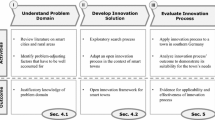Abstract
The objective of this paper is to address the smart innovation ecosystem characteristics that elucidate the assembly of all smart city notions into green, interconnected, instrumented, open, integrated, intelligent, and innovating layers composing a planning framework called, Smart City Reference Model. Since cities come in different shapes and sizes, the model could be adopted and utilized in a range of smart policy paradigms that embrace the green, broadband, and urban economies. These paradigms address global sustainability challenges at a local context. Smart city planners could use the reference model to define the conceptual layout of a smart city and describe the smart innovation characteristics in each one of the six layers. Cases of smart cities, such as Barcelona, Edinburgh, and Amsterdam are examined to evaluate their entirety in relation to the Smart City Reference Model.

Similar content being viewed by others
References
European smart cities—project. http://www.smart-cities.eu/. Accessed 2 April 2011
Caragliu A, Del Bo C, Nijkamp A (2009) Smart cities in Europe. University Amsterdam, Faculty of Economics, Business Administration and Econometrics
Toppeta D (2010) The smart city vision: how innovation and ict can build smart, “liveable”, sustainable cities. THINK! REPORT 005/2010
Cozens M (2008) New urbanism, crime and the suburbs: a review of the evidence. Urban Policy and Research 26(4):429–444
Greenburg E (2004) Codifying new urbanism: how to reform municipal land development regulations. American Planning Association PAS Report Number 526
Marshall D, Toffel W (2005) Framing the elusive concept of sustainability: a sustainability hierarchy. Environ Sci Technol 39(3):673–682
McGeough U, Newman D (2004) Model for sustainable urban design with expanded sections on distributed energy resources. Sustainable Energy Planning Office Gas Technology Institute and Oak Ridge National Laboratory GTI Project # 30803-23/88018/65952
Atkinson R, Castro D (2008) Digital quality of life. The Information Technology and Innovation Foundation. pp. 137–145
Belisent J (2010) Getting clever about smart cities: new opportunities require new business models. Forester
Shapiro J (2003) Smart cities:explaining the relationship between city growth and human capital. Harvard University
Adams W (2006) The future of sustainability, re-thinking environment and development in the twenty-first century. The World Conservation Union
American Smarter Cities. http://smartercities.nrdc.org. Accessed 3 March 2011
Amsterdam Living Lab, http://www.amsterdamlivinglab.nl/page/109/en. Accessed 4 May 2011
Amsterdam Smart City, http://www.amsterdamsmartcity.com/. Accessed 14 March 2011
Artemis Sofia project. http://sofia-project.org/. Accessed 14 March 2011
Barcelona city council. http://www.bcn.es/english/ihome.htm. Accessed 3 April 2011
Barcelona. Smart city 22@ http://www.22barcelona.com. Accessed 14 March 2011
Barcelona urban studies. http://geographyfieldwork.com/barcelona.htm. Accessed 3 April 2011
Bell R, Jung J, Zacharilla L (2009) Broadband economies: creating the community of the 21st century. Intelligent Community Forum
Bizer C, Heath T, Berners-Lee T (2009) Linked data – the story so far. Issue on Linked Data, International Journal on Semantic Web and Information Systems (IJSWIS)
Blewitt J (2008) Understanding sustainable development. Earthscan, London, pp 21–24
Gillett E, Lehr H, Osorio C (2004) Local government broadband initiatives. Telecommun Policy 28(7):537–558
Ergen M (2009) Mobile broadband—including WiMAX and LTE. Springer, NY
Chee-Yee C, Kumar S (2003) Sensor networks: evolution, opportunities, and challenges. Proc IEEE 91(8):1247–1256
Leon N (2006) The well connected city A report on municipal networks Supported by The Cloud. Imperial College London
Komninos N (2006) The architecture of intelligent cities; Integrating human, collective, and artificial intelligence to enhance knowledge and innovation. 2nd International Conference on Intelligent Environments, Institution of Engineering and Technology, Athens
Florida R (2003) The rise of the creative class and how it’s transforming work, leisure, community and everyday life. Perseus Books Group
Intelligent Community Forum. http://www.intelligentcommunity.org/. Accessed 25 February 2011
Ford G, Koutsky K (2005) Broadband and economic development: a municipal case study from Florida. Applied Economic Studies
OECD (2009) Smart sensor networks: technologies and applications for green growth. Working Party on the Information Economy (WPIE)
SISCO. http://www.cisco.com/web/CN/expo/en/index.html. Accessed 12 April 2011
OECD, Internet (2008) broadband and the economy. Seoul Ministerial Meeting On the Future of the Internet Economy
Partridge H (2004) Developing a human perspective to the digital divide in the smart city. Alia
LEED, Leadership in Energy and Environmental Design http://www.usgbc.org. Accessed 22 April 2011
EU Strategic Energy Technology (SET) plan http://ec.europa.eu/energy/technology/set_plan/set_plan_en.htm. Accessed 12 March 2011
Cappellin R (2007) Learning, spatial changes, and regional and urban policies. The Territorial Dimension of the Knowledge Economy, American Behavioral Scientist, Volume 50, Number 7
IBM smart cities. http://www.ibm.com/ibm/smartercities/us/en/. Accessed 12 February 2011
Green K (2007) A wireless sensor city. MIT Technology Review, April 13th, MIT, Cambridge, MA
Wilson J (2008) Sensor technology handbook. Newnes/Elsevier, Oxford
COM (2009) Communication from the commission to the European Parliament, the Council, the European
Landi G, Laura G, Memeo V, Pucci P, Rapp S (2009) A unified smart city environment based on SOFIA’s Interoperability Open Platform. SOFIA ARTEMIS
EU Smart Grids Task Force. http://www.smartgridtoday.com/public/939.cfm. Accessed 24 March 2011
Wei Y, Blake B (2010) Service-oriented computing and cloud computing: challenges and opportunities. IEEE vol. 14 no. 6
Santander Smart City, http://www.smartsantander.eu/. Accessed 10 March 2011
Komninos, N, Sefertzi, E (2009) Intelligent cities: R&D offshoring, web 2.0 product development and globalization of innovation systems. Second Knowledge Cities Summit, Shenzhen, China
Komninos N (2008) Intelligent cities and global innovation networks. Routledge, London
OECD (2003) The e-government imperative: main findings, Policy Brief, Public Affairs Division, Public Affairs and Communications Directorate
The creative class. http://www.creativeclass.com/. Accessed 10 March 2011
Urenio Smart city portal. http://www.urenio.org/2011/04/20/amsterdam-smart-city-smart-stories-2011/. Accessed 4 February 2011
Smart city Edinburgh. http://www.edinburgh.gov.uk. Accessed 5 March 2011
Wi-fi library services of the Edinburgh city council http://www.edinburgh.gov.uk/libraries
Author information
Authors and Affiliations
Corresponding author
Rights and permissions
About this article
Cite this article
Zygiaris, S. Smart City Reference Model: Assisting Planners to Conceptualize the Building of Smart City Innovation Ecosystems. J Knowl Econ 4, 217–231 (2013). https://doi.org/10.1007/s13132-012-0089-4
Received:
Accepted:
Published:
Issue Date:
DOI: https://doi.org/10.1007/s13132-012-0089-4




